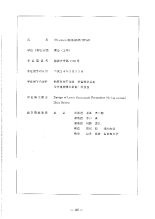Design of loose spacecraft formation flying around halo orbits ハロー軌道まわりの粗編隊飛行の設計手法
この論文にアクセスする
この論文をさがす
著者
書誌事項
- タイトル
-
Design of loose spacecraft formation flying around halo orbits
- タイトル別名
-
ハロー軌道まわりの粗編隊飛行の設計手法
- 著者名
-
Simanjuntak, Triwanto
- 著者別名
-
シマンジュンタク, トリワント
- 学位授与大学
-
総合研究大学院大学
- 取得学位
-
博士 (工学)
- 学位授与番号
-
甲第1490号
- 学位授与年月日
-
2012-03-23
注記・抄録
博士論文
Two spacecraft or more are assumed to be in a state of loose formation flying around a collinear Lagrangian point in the Sun-Earth Circular Restricted Three-Body Problem (CRTBP) system. The orbit reference of choice for the leader is a Halo orbit and the followers are assumed to follow nearby and be constrained either geometrically or in size. This type of formation could be useful in the future for constructing space ports, space telescopes, astronomical spacecraft requiring sun shields and, with greater num- bers, spacecraft swarm missions. The formation design method is constructed by firstly seeking the local coordinate system from the monodromy matrix through extraction of the independent bases which span the space of the Halo orbit. To nullify diverging and converging motion, we confine the relative motion to within the periodic subspaces. Two types of formations are studied in this thesis, natural loose formations and periodic loose formations with impulsive control. For natural formations, two modes of relative motion within these subspaces, long-term and short-term motions. In this study, the long-term motion is approximated by deriving a discrete formulation of independent directions based on the eigenvectors of the monodromy matrix, while for the short-term motion the fundamental set solutions are modeled using Fourier series and additional linear func- tions. Since the size of the formation discussed is significantly smaller than that of the Halo orbit, the formation design method can fundamentally be stated as a process of linearly combining these approximations to achieve the desired formation. Consequently, use of this approach transforms formation design from a differential equation problem into an algebraic one, and furthermore enables the long-term and short-term motion design problems to be handled either jointly or separately. To increase design degree of freedom impulsive control is introduced to the formation problem. The use of single, two and three impulses are specially discussed in detail. Design examples, both for natural and with impulsive control formation are presented to demonstrate the validity of the design method. Keywords: Restricted Circular Three-Body Problem, Loose Formation Flying, Halo Orbits, Impulsive Control
総研大甲第1490号
